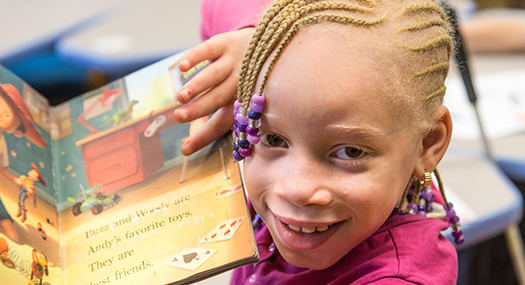Bookmaking is one of the most satisfying literacy experiences an adult can share with a child. The process of creating a book promotes oral language and fine motor skills, while developing many important literary concepts.
Guidelines for Creating Books
Let the child help to choose the topic.
Spend lots of time talking about the subject before writing.
When making tactile pictures, keep them as simple as possible, and let your child help with cutting, stapling, and gluing. Use a diagonal strip of film for a slide or a piece of fur for a cat; complex details are usually not necessary. Be sure your child has had experience with the real object so that these simple representations will be meaningful. Invest in a small hot glue gun for attaching heavier objects to book pages.
If your child has useful residual vision, she may enjoy drawing and coloring pictures for her books. Even if your child does not have any vision, she may still enjoy coloring. Anti-roll crayons (see Sources of Adapted Materials) have a flat side that can easily be labeled with a color word in braille. A screen board (a piece of window screen securely fastened with duct tape to a stiff sheet of cardboard) can be used under the paper your child is coloring on; the texture of the screen will come through and add tactile feedback to the crayon marks.
Compose words and sentences together with your child.
Verbalize sounds and words as you write on the braillewriter.
Let your child write a "word" or a "sentence" below yours by pressing random keys on the brailler. Or, if he already knows some words or letters, he may want to help you write the text.
When all of the pages are finished, decide on the order together and number them in braille.
Cut a front and back cover of appropriate size and bind the book with rings, staples, or plastic comb binding (many schools have machines that will bind student-made books). You might also like to use a thin 3-ring binder to hold the pages, particularly if you may be adding to the book in the future.
Suggested Books to Make with Your Child
Texture book with a cover in the shape of a hand; one texture per page accompanied by a braille word describing the texture. (See attached hand template.)
Counting book made from rectangular posterboard pages with textured shapes and everyday objects; for example, 1 jar lid, two fuzzy triangles, 3 squares, 4 pieces of masking tape, 5 paper fasteners, 6 large paper clips slipped over the top edge of the page, 7 staples, 8 stick-on stars, 9 holes punched with a hole puncher, 10 cuts made along one edge of the page with scissors. Attach the appropriate braille number to each page.
Point book including a fork, toothpick, pushpin, triangle, paper fastener, paper clip, and so forth.
Fastener book made by attaching a textured shape to each page in a different way: staple, glue, paper fastener, metal ring, paper clip, tape, and twist tie.
Experience book focusing on a daily activity such as breakfast or a special event like a trip to the pumpkin patch. Use real objects as pictures when possible (for example, a plastic spoon, napkin, and small plastic bag of cereal for breakfast) or simple textured shapes to represent objects with which the child is familiar (such as a cardboard rectangle with small squares around it to represent the table and chairs). Some children like to include photographs of themselves in experience books to share with sighted family members and friends.
Shape book focusing on a simple shape, such as a circle. Round objects such as lids, buttons, and coins can be hot-glued to each page.
Book About Me which tells about your child! Could include favorite objects, photographs or tactile illustrations of family members (e.g., Grandpa's scratchy sweater), whatever your child wants to share.
